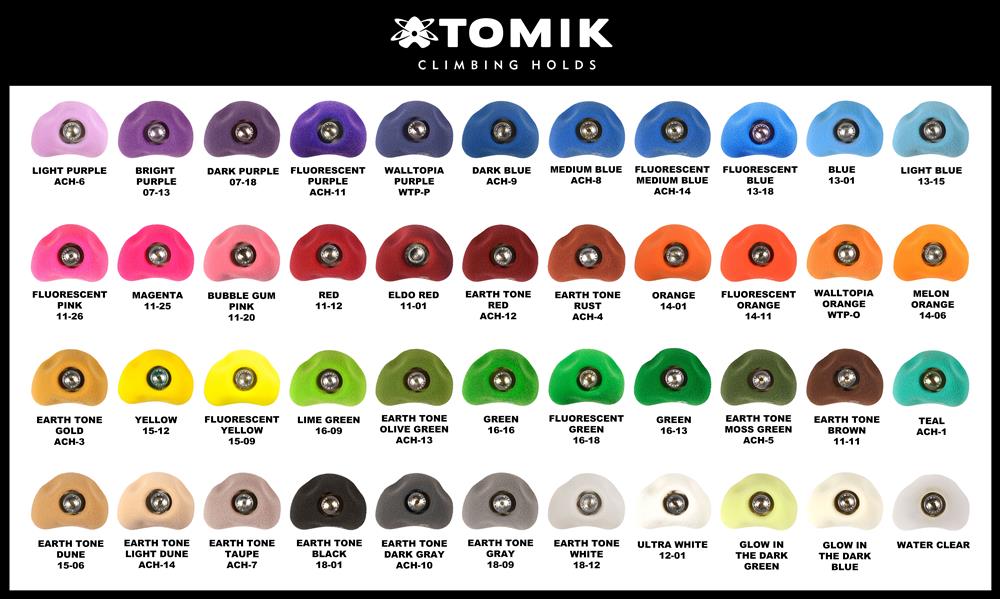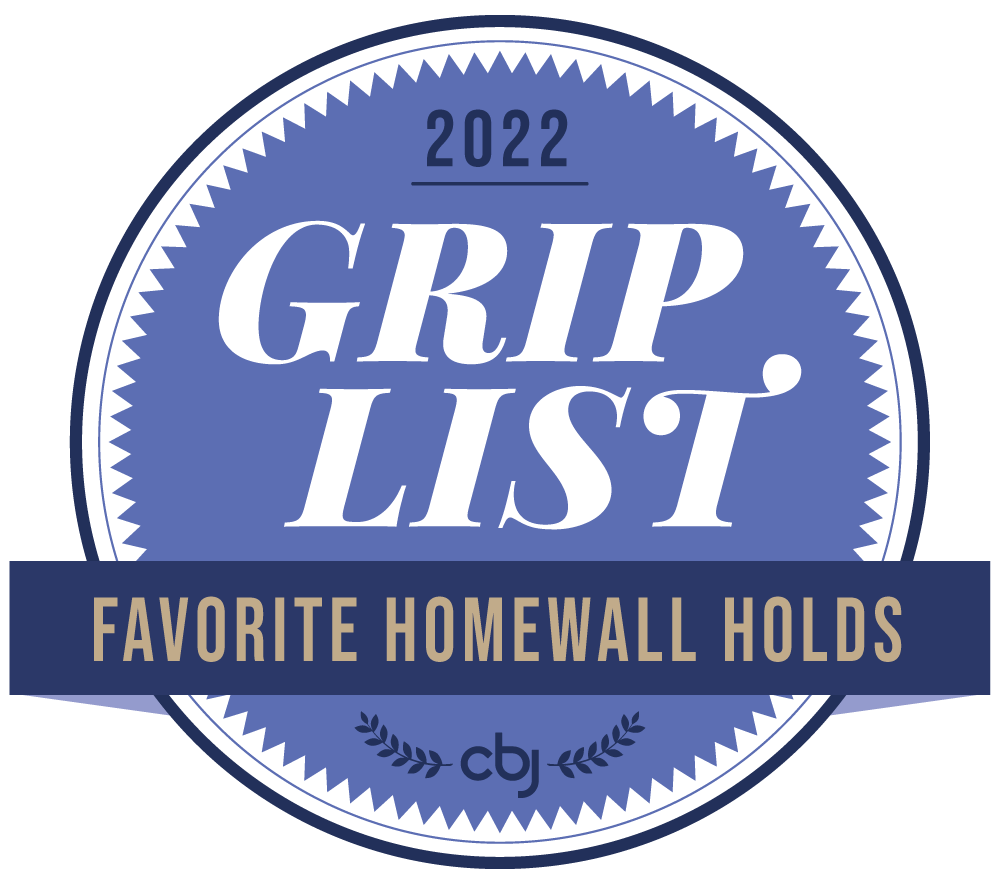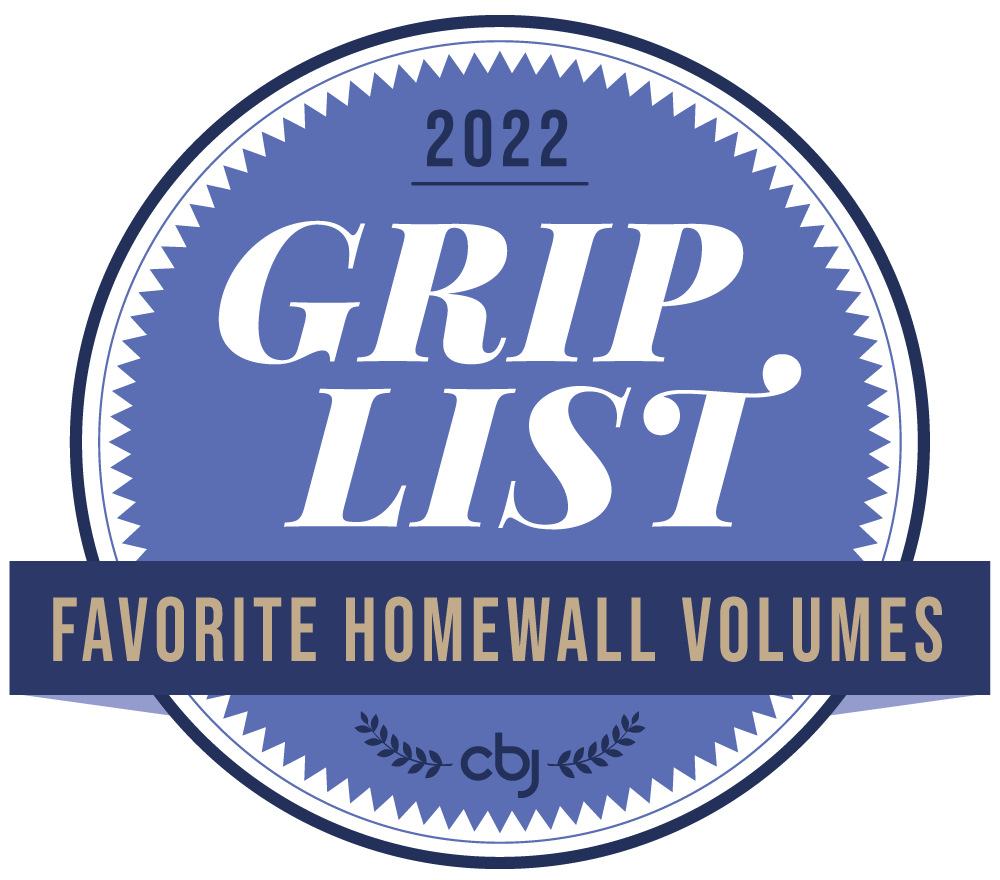FAQs
Frequently Asked Questions
Atomik's website provides a lot of information but please don't hesitate to contact us if you need assistance. We're here to help. If you get our voicemail during business hours, it's only because we are on the phone with another client or on the production floor in our facility. Please leave a message and we will return your call as soon as possible. You can also ask your question via email.
If the information here hasn't quite answered your questions, please follow this link to our How To Build A Climbing Wall page. Our How-To section is full of much more detailed information to help you on your way.
Kenny Matys
President - Atomik Climbing Holds
_____________________________________________________
Table of Contents
Hardware
- What length of bolts should I choose?
- How many t-nuts should I get?
- What size holes do I drill for the t-nuts?
Ordering
- When will my order arrive?
- What about backorders?
- Is the hardware included?
- What are Atomik's climbing holds made out of and how does it compare to other products?
- Can I order using a Purchase Order?
Holds
- When will my order arrive?
- What is the difference between a bolt-on hold and a screw-on hold?
- Are the holds guaranteed?
- What is the texture like?
- Are bolt-ons better than screw-ons?
- What color of holds should I buy?
Wall Building
- What pattern should I use for the t-nuts?
- Are the holds weather resistant?
- Can I mount climbing holds on drywall?
- Can I attach plywood directly to a concrete wall?
- What should I build my wall out of?
- How to build a System Wall.
- How to build a Hang Board.
Hardware
1. What length of bolts should I choose?
It's a trick question! You don't choose the bolt length on our website. You are choosing the wall surface thickness. The 3/4, 1" and 1.5-inch options are telling us the thickness of your climbing wall surface. 3/4" for plywood, 1" for Trex and/or 5/4 board and finally 1.5" for walls that are faced with 2x6, 2x8, or 2x10 boards.
2. How many t-nuts should I get?
The industry standard is 2.25 t-nuts per square foot of wall surface. So as an example, if you have an 8 foot by 8-foot wall ( 64 square feet ), you should get 2.25 x 64 = 144 t-nuts.
3. What size holes do I drill for the t-nuts?
You should drill a 7/16" hole which is the outside diameter of the t-nut (unless you are installing Industrial T-nuts, then it's a 1/2" hole). I prefer using a spaded wood bit. Be sure to drill from the front of the panel through to the back. Let the bit do the work. Forcing the bit through the wood causes the wood to "blow out". Click here for more details http://atomikclimbingholds.com/wall.pdf
Ordering
1. When will my order arrive
Once we have boxed up your order, the counting of days in transit starts the day after your order is picked up by UPS. The West Coast is 2 business days away from us. The North East Coast is 5 and the South East is 4. UPS does not count the day the order was picked up as a business day.
2. What about backorders?
We are the manufacturer, therefore back ordered items are rare.
3. Is the hardware included?
No, but our website is coded to offer several hardware options. You can add hardware on the page you see the product you want.
4.What are Atomik's climbing holds made out of and how does it compare to other products?
Atomik uses a polyurethane resin. We use this resin because it offers an outstandingly strong product and it allows us to be environmentally responsible. Polyurethane does not typically emit significant amounts of either EPA-listed VOCs or "semi-VOCs."
Volatile organic compounds (VOCs) refers to organic chemical compounds which have significant vapor pressures and which can affect the environment and our employee's health. Polyester resin does not afford us these benefits. It is weaker and gives off very high VOCs.
5. Can I order using a Purchase Order?
- Create an account
- Fill your shopping cart with the items you need.
- Checkout.
- When you get to the Payment Method, choose Purchase Order for the payment option. You will be prompted to type in your Purchase Order # in the box below.
- Immediately after checkout, email us a copy of the actual PO to cs@atomikclimingholds.com. We CANNOT ship your order until we receive your PO.
Holds
1. How many climbing holds should I get?
The standard of 1 to 1.5 holds per 2 square feet of climbing wall area unless you have children not yet in Kindergarten. 1 hold for every square foot of climbing area is what I recommend for the little tykes. I recommend this number because it is not the size of hold that poses the challenge but the distance from one hold to the next. Home and commercial gym bouldering walls almost always see a much higher concentration of holds.
2. What is the difference between a bolt-on hold and a screw-on hold?
A bolt-on hold attaches with one 3/8-16 Allan head bolt which passes through the hold, into the wall surface which has an embedded 3/8-16 t-nut. A screw-on hold attaches with 2 or more wood or concrete Tapcon screws.
3. Are the holds guaranteed?
We provide a Lifetime Warranty on our holds. We use a high-quality polyurethane resin with grade 8 washers that provide a great product. Atomik has an impressive less than 0.0001% warranty rate. Yes, 1 hold in every ten thousand for the past 5 years. In the event you do end up in this rare event, we will replace the broken hold with two. All we ask is for a digital photograph emailed to us so we can track how it happened.
4.What is the texture like?
Our texture feels like clean sandstone. Similar to 120 grit sandpaper. One of the differences between Atomik and other polyurethane climbing hold companies is that our proprietary process affords us to offer a rock-like texture and feel. The real benefit is that if you want a more skin-friendly texture, simply use a sanding sponge or paper and rub the hold. On my wall, I leave all my slopers and small incuts as is. I like the texture. On big holds that see my whole hand on it with full body weight, I comfortize them. That way I can "hang on my skin" longer. It's a personal preference. Sleep easy knowing that you have choices with Atomik's product.
5.Are bolt-ons better than screw-ons?
In my opinion, yes. You can move them easily, loosen them slightly to rotate, and re-tighten with ease and you can tighten them down pretty much as hard as you want within reason. Screw-ons have their virtues though. Since very little hardware is needed, the cost-benefit certainly poses the question as to why not. Screw-ons attach with a 3/16 x 1 3/4 long Tapcon screw. The pilot hole that is drilled using a hammer drill is 5/32 in diameter.
6. What color of holds should I buy?
We offer 39 different colors! Bright tones are best for children's walls. Earth tones offer a more mellow, outdoor feel to your wall. Fluorescent tones certainly make a statement. You can choose from individual colors, select your own custom assortment of colors, choose from our pre-determined color selections, or even have a custom color made just for you.

.jpg)
Wall Building
1. What pattern should I use for the t-nuts?
Staggered is best. That means if you stand your 4 x 8 sheet tall and measure from the top left to the right, the first t-nut is 2 inches in and 4 inches down. You should have 6 t-nuts on that first row measuring to the right, spaced 8 inches apart with the last t-nut 6 inches from the right edge. The second row is 6 inches in and 12 inches down. This row will also have 6 t-nuts in the row and 8 inches apart. The last t-nuts will end up 2 inches from the right edge of the panel. Click here for an image and details T-nut Layout
2. Are the holds weather resistant?
Indoors our outdoors, Atomik holds stand the time of time. Mother Nature does have a nasty child called UV rays and that will fade all holds over time. Yes, we can UV coat them but to be honest, all that does is slow the fading down. In our opinion, it's not worth charging you the extra money for the coating.
3. Can I mount climbing holds on drywall?
No, no, no. Drywall is NEVER structural. Please do not think you can " hit the studs in the wall" and be safe. It is not.
You have 2 options:
- Lay the sheets of 3/4 inch plywood directly against the drywall and attach it to the studs. We recommend only using screw-on climbing holds for this method of attaching the plywood.
- Lay 2 x 4s flat against the wall attaching them through the drywall and into the wall studs with at least 1 inch of thread from the screw you are using. The math is, 3/4 plywood + 1.5 inches ( 2 x 4 actually measures 1.5" x 3.5" ) + 1/2 drywall + 1 inch of addition thread = 3.75 inch long screw. Option #2 allows a bolt-on or screw-on hold to be used. The extra 1.5 inches that the 2 x 4 offers allow a bolt to pass through the hold, through the panel and t-nut, and then into the space you created. Many think, "well why not just get exact bolt lengths?" In a perfect world, yes but the amount of thread that comes out the back of each hold varies.
4. Can I attach plywood directly to a concrete wall?
Yes, you can but you need to " fur out " the plywood using furring strips. We recommend laying 2 x 4s flat against the wall attaching with Tapcons or wedge bolts. The extra 1.5 inches that the 2 x 4 offers, allows a bolt to pass through the hold, through the panel and t-nut, and then into the space that you created so that the bolt does not push the panel away from the wall. Many think, "well why not just get exact bolt lengths?" In a perfect world, yes but the amount of thread that comes out the back of each hold varies. DO NOT LAY A SHEET OF PLYWOOD FLAT AGAINST A CONCRETE WALL WITHOUT FURRING STRIPS!
5 .What should I build my wall out of?
- Indoor walls
3/4 inch Plywood and 3/4 inch OSB are strong, durable, and longstanding, so you don't have to be concerned about the performance comparison in that area. And, as with any wood product, you need to make sure to select the proper grade. ACX in plywood is the fancy term for one side is good. OSB is relatively the same on both sides. The commercial gyms that look like real rock often use OSB because it gets covered with a stucco-like covering. - Outdoor walls
- Trex: It will not rot or deteriorate due to harsh weather or insects. Trex is splinter-free and has excellent traction, even when wet. It contains no toxic chemicals or preservatives. Trex resists damage from moisture and sunlight, making it the natural choice for pools, hot tubs, and spas. Trex is available in a wide range of colors and finishes to suit any style.
- Pressure Treated Lumber:
Pressure-treated lumber is a good choice for standing up to Mother Nature. It does have a bad reputation with people who hear " chemically infused wood" and say "shame on you" when we even mention it. Until 2003, the preservative most commonly used in residential pressure-treated lumber was chromated copper arsenate (CCA). It is an extremely toxic chemical for humans. However, one must distinguish between the toxicity of the chemical and the toxicity of the wood product in everyday use. The facts are that your local home store or lumberyard is now selling lumber treated with less toxic alternatives... amine copper quat (ACQ) and copper azole (CA)... though you may find other chemical combinations in specific areas. The reason these new copper-based alternatives are considered safer than arsenic-based preservatives is based on the human body's inability to absorb these poisons. To sum it all up, the pressure-treated wood you get locally isn't as bad as people make it out to be. It's a great product. When I handle it, I wear gloves, a face mask when cutting it and I wash my hands once I have finished handling it. PT comes in plywood, 1 x 6 (aka 5/4 board ), 2x6, 2x8. - Plywood:
I'm not a big fan of plywood outside. The edges are untreated so when even a little water gets on it, delamination and bloating happen. Using pressure-treated plywood is the best choice if you are adamant about using plywood. I recommend drilling the panels, priming the wood, and then painting it. I am a little crazy and I might even spray inside the holes ( No t-nuts are installed at this point ). - Cedar:
Cedar is incredibly resistant to rot and insects just don't like cedar. Its bacterial and fungal resistance coupled with the fact that Cedar is 80% the strength of Oak, makes it a desirable wood to use for the building project. Cedar is a lightweight and dimensionally stable wood that lies flat and stays straight, which means it resists the natural tendency to crack and check as you might find in many other wood species. I personally have never worked with cedar in a climbing environment but it does have a compelling sales pitch. Keep in mind that it has to be 3/4 or thicker in order to accommodate the length of the t-nut shaft.
6. How to build a System Wall.
System Walls are easy. The key is to chalk line the entire panel so that you have a very dense grid pattern of t-nuts for maximum places to move holds to. Normally a climbing wall will have 72 t-nuts on a sheet of plywood. 144 t-nuts on a sheet of plywood ( 4 inches apart ) is not uncommon. You won't use most of them but what you will have is a t-nut in the exact place you want it to. Consider it this way, at $0.10 each, $14.40 for 144 worth of t-nuts is a sound investment for ultimate hold placement options.
7. How to build a Hang Board.
- Decide on your width. 24" is most bathroom doors. 30" is the standard bedroom door, 36" is the standard entry door.
- Cut your plywood to the size you want. We recommend 12 inches tall. 12" gives you enough room for 2 rows of holds. Mine is 24" tall and I don't even put holds in the top section. You are pretty far off the ground at the top of a 24" tall board.
- Using leftover 3/4 plywood, cut 5 furring strips that are 1.5 inches wide. and at least the width of your desired width. Cut to size the left and right side furring strips. Attach to the back of the panel using glue and finishing nails. Now add 3 horizontal strips that fit in between the left and right sides. One on the top, one in the middle, and one on the bottom. Now you have at least 3 places per stud to screw in to. Drill 7/16 holes into the panel 4 inches apart laid out in a staggered pattern. Be sure to miss your furring strips.
- Leave the panel raw at this point or finish it. See How to Build A Wall on how to do this.
- Hammer t-nuts into the holes on the backside of the panel.
- Find out where your studs are over your door frame and mark them. Mark your plywood where it will line up with the studs and pre-drill 3 pilot holes through the furring strips for each stud. Top, middle, and bottom.
- Attach board into studs using #8 x 3" wood screws for an interior application or 3" concrete screws to attach to a concrete wall.


